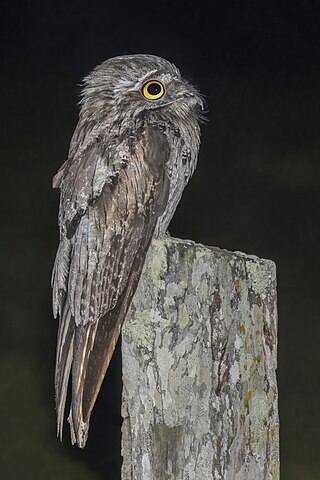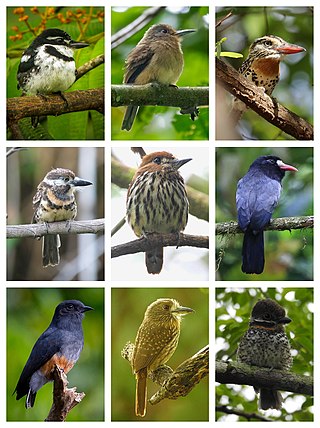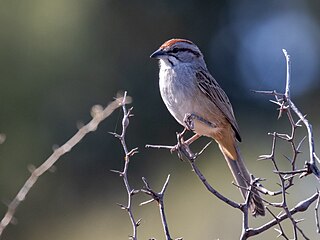
A phalarope is any of three living species of slender-necked shorebirds in the genus Phalaropus of the bird family Scolopacidae.

Serinus is a genus of small birds in the finch family Fringillidae found in West Asia, Europe and Africa. The birds usually have some yellow in their plumage. The genus was introduced in 1816 by the German naturalist Carl Ludwig Koch. Its name is Neo-Latin for "canary-yellow".

Potoos are a group of birds related to the nightjars and frogmouths. They are sometimes called poor-me-ones, after their haunting calls. The family Nyctibiidae was formerly included with the nightjars in the order Caprimulgiformes but is now placed in a separate order, Nyctibiiformes. There are seven species in two genera in tropical Central and South America. Fossil evidence indicates that they also inhabited Europe during the Paleogene.

The puffbirds and their relatives in the family Bucconidae are tropical tree-dwelling insectivorous birds that are found from South America up to Mexico. Together with their closest relatives, the jacamars, they form a divergent lineage within the order Piciformes, though the two families are sometimes elevated to a separate order Galbuliformes. Lacking the iridescent colours of the jacamars, puffbirds are mainly brown, rufous or grey, with large heads, large eyes, and flattened bills with a hooked tip. Their loose, abundant plumage and short tails makes them look stout and puffy, giving rise to the English name of the family. The species range in size from the rufous-capped nunlet, at 13 cm (5.1 in) and 14 g (0.49 oz), to the white-necked puffbird, at up to 29 cm (11 in) and 106 g (3.7 oz).

Ovenbirds or furnariids are a large family of small suboscine passerine birds found from Mexico and Central to southern South America. They form the family Furnariidae. This is a large family containing around 321 species and 71 genera. The ovenbird, which breeds in North America, is not a furnariid – rather it is a distantly related bird of the wood warbler family, Parulidae.

The woodcreepers (Dendrocolaptinae) comprise a subfamily of suboscine passerine birds endemic to the Neotropics. They have traditionally been considered a distinct family Dendrocolaptidae, but most authorities now place them as a subfamily of the ovenbirds (Furnariidae). They superficially resemble the Old World treecreepers, but they are unrelated and the similarities are due to convergent evolution. The subfamily contains 60 species in 16 genera.

The white-eyes are a family, Zosteropidae, of small passerine birds native to tropical, subtropical and temperate Sub-Saharan Africa, southern and eastern Asia, and Australasia. White-eyes inhabit most tropical islands in the Indian Ocean, the western Pacific Ocean, and the Gulf of Guinea. Discounting some widespread members of the genus Zosterops, most species are endemic to single islands or archipelagos. The silvereye, Zosterops lateralis, naturally colonised New Zealand, where it is known as the "wax-eye" or tauhou ("stranger"), from 1855. The silvereye has also been introduced to the Society Islands in French Polynesia, while the Japanese white-eye has been introduced to Hawaii.

The sagebrush sparrow is a medium-sized sparrow of the western United States and northwestern Mexico. It used to be placed in the genus Amphispiza, but evidence from 2007 and 2009 suggested it be placed in its own genus.

The rufous-crowned sparrow is a small American sparrow. This passerine is primarily found across the Southwestern United States and much of the interior of Mexico, south to the transverse mountain range, and to the Pacific coast to the southwest of the transverse range. Its distribution is patchy, with populations often being isolated from each other. Twelve subspecies are generally recognized, though up to eighteen have been suggested. This bird has a brown back with darker streaks and gray underparts. The crown is rufous, and the face and supercilium are gray with a brown or rufous streak extending from each eye and a thick black malar streak.

Cassin's sparrow is a medium-sized sparrow.

Aimophila is a genus of American sparrows. The derivation of the genus name is from aimos/αιμος "thicket" and phila/φιλα "loving".

The Cape clapper lark is a small passerine bird which breeds in southern Africa. It derives its name from the wing clapping which forms part of the display flight. The Cape clapper lark is a species of open grassland and savannah, also inhabiting karoo, fynbos and fallow agricultural land.

Leucopternis is a Neotropical genus of birds of prey in the family Accipitridae. They are associated with tropical forest, and are uncommon or rare. Their plumage is largely black or gray above and white below, and they have distinctive orange ceres.

The flappet lark is a species of lark in the family Alaudidae that is widespread across Sub-Saharan Africa. The name flappet originates from the distinctive wing flapping sound made during its breeding season.

The Chaco sparrow, formerly known as the stripe-capped sparrow, is a species of bird in the family Passerellidae. It is found in Argentina and Paraguay.

Green toucanets are near-passerine birds from the genus Aulacorhynchus in the toucan family. They are native to Mexico, and Central and South America. All are found in humid forests and woodlands in highlands, but a few also occur in adjacent lowlands. They are relatively small toucans, 30–44 centimetres (12–17 in) long, with colorful, mainly green, plumage. They are typically seen in pairs or small groups, and sometimes follow mixed species flocks.

Chroicocephalus is a genus of medium to relatively small gulls which were included in the genus Larus until genetic evidence published in 2005 showed that Larus as then constituted was paraphyletic. Ten species are currently accepted. An eleventh, Saunders's gull, was included until a 2022 study demonstrated that it did not belong in Chroicocephalus; it is now treated in its own genus Saundersilarus. The genus name Chroicocephalus is from Ancient Greek khroizo, "to colour", and kephale, "head".

Peucaea is a genus of American sparrows. The species in this genus used to be included in the genus Aimophila.

Bell's sparrow is a medium-sized sparrow of the western United States and northwestern Mexico. It used to be placed in the genus Amphispiza, but recent evidence suggested it be placed in its own genus.

The Yungas sparrow is a species of bird in the family Passerellidae endemic to the Southern Andean Yungas of southeastern Bolivia and northwestern Argentina. It was formerly considered a subspecies of what was then called the stripe-capped sparrow.

























